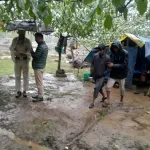From University of Oxford ( UK) to Shar-e Kashmir University of Agriculture Sciences and Technology- Kashmir ( SKUAST-K), plant biotechnologist Dr Amjad M Husaini has made immense contributions to saffron research and its extension in Jammu and Kashmir.
Amjad M Husaini, a doctorate in biotechnology from Jamia Hamdard University, New Delhi, is associate professor and senior scientist at division of plant biotechnology, SKUAST-K.
He is the first scientist to use activity based protein profiling( ABPP) technique to profile various enzymes present in the stigma of saffron at five different developmental stages.
His cutting edge research was published in one of the highly rated journals, Plant Physiology, brought out by American Society of Plant Biologists in 2018.
The research was carried by him in the prestigious plant chemetics laboratory at University of Oxford after bagging DBT CREST Fellowship in 2015.
Amjad told Rising Kashmir that in 2015 University of Oxford was working on developing a breakthrough technology, activity based protein profiling, for model plant ( plant used for study) Arabidopsis Thaliana.
“ I requested my research head at Oxford for using this technique for saffron in addition to Arabidopsis, knowing that the laboratory was having no mandate to work on saffron,” Amjad said, adding that he wished to use a crop which is cultivated in his home country so that his research becomes a base for further study on the herb. He said that his request was approved and as such his was the first of its kind study on saffron in the world.
Afterwards he wished to study corm rot in saffron, a disease caused by fungus, Fusarium Oxysporum, but head of chemetics laboratory at that time Professor, A L Vander Hoorn didn’t approve it as they required a licence to carry a direct study on the pathogen at the university.
Instead, the professor suggested Amjad to get the experiment conducted at some other place and afterwards he can use ABPP technology for the study. Driven by his will to carry out the research on corm rot in Saffron, Amjad collaborated with two researchers, Daneil Palmero from Madrid University, Spain and Ousama Ahrazem from Abacete University, Spain who carried out basic experiments on the fungus and latter sent him cell free extracts of infected and normal plants.
Amjad used Multiplex Fluorescent activity based protein profiling to study changes in hydrolase activities in the corms up on infection with Fusarium Oxysporum.
Back at home, Amjad found adulteration of saffron as a big problem where unscrupulous elements sell fake saffron as genuine.
“The practice breaks the confidence of a consumer and is detrimental for saffron economy of Jammu and Kashmir,” Amjad said, adding that for detection of fake strands sophisticated laboratories are required.
He said that it was under this backdrop that Department of Biotechnology, Government of India, invited proposals for developing a customer centric method to detect fake saffron.
“ We used fold scope, a paper microscope, for the first time in the world for developing a customer centric method to detect fake saffron,” Amjad said, adding that a fold scope is attached to a smart phone with the help of a magnetic coupler.
He added that a strand is placed under the fold scope and the image is viewed on the mobile phone screen.
He said that image of stigma helps the customer in identifying its purity.
He said that pure stigma ( saffron) has finger-like projections called papillae.
“ Absence of papillae is an indication of adulteration,” he said.
Besides, the scientist has developed a model using artificial intelligence and machine learning which can automatically detect whether a sample is pure or adulterated.
“The customer needs to click a photograph and he will be able to find purity of the sample through yes or no options,” he said, adding he has applied for patent for this technology .
He has also come up with a chemical based method to check purity of saffron. The scientist said he doesn’t want to elaborate on this technique before it gets published. Amjad has sought patent rights for this technique also.
Amjad and et al. presented a detailed research paper on Saffron as a potential drug supplement for severe acute respiratory syndrome coronavirus (COVID) management.
The paper was published by ‘Cell Press’ journal in May 2021, and was the first article with in depth analysis on the possibility of using Saffron in management of COVID-19 and post covid long-term sub-acute and chronic abnormalities associated with it.
In the research Paper Amjad and et al discussed the potential role of saffron during and after COVID-19 infection with focus on immunomodulation, respiratory, renal, and cardiovascular functions.
They stated that as a nutraceutical or drug supplement, it can alleviate the magnitude of COVID-19 symptoms in patients.
“The anti-inflammatory, antioxidant, and other medicinal properties attributed to saffron bioactive compounds can help in both pre-and post-infection management strategies,” Amjad and et al. stated, adding that the abnormalities associated with COVID-19 survivors include anxiety, depression, sleep disturbances, and post-traumatic stress disorder.
“Saffron can help manage these post-hospitalization abnormalities owing to its anti-depressant property. It can help common people boost immunity and manage depression, stress and anxiety caused due to prolonged lockdown, isolation or quarantine,” they further stated, cautioning that the purpose is not to present saffron as a solution to COVID-19, but only to explore its use in the integrated management of COVID-19. “It needs to be evaluated for its potential role in the long-term physical and mental health management strategy of COVID-19 patients,” the paper reads.
Amjad said that saffron has the potential to block angiotensin-converting enzyme 2 (ACE2) receptor through which SARAS CoV -2 binds to gain entry into epithelial cells and as such can reduce chances of the infection.
In 2016, He won a grant under National Mission for Himalayan studies wherein he demonstrated at a large scale that Saffron can be grown in non traditional areas of Jammu and Kashmir.
“ The demonstration was carried out in 10 districts of Kashmir valley and 5 districts of Jammu province,” Amjad said, adding that it was first such demonstration in Jammu and Kashmir which depicted that Saffron can be grown outside of its traditional zone.
The scientist was instrumental in familiarising women folk in various areas of Jammu and Kashmir with organic saffron kitchen gardens .
For his outstanding work, Amjad has won many awards including Jawaharlal Nehru Award and Senior Common Room( SCR) Membership award by Somerville College, University of Oxford.





